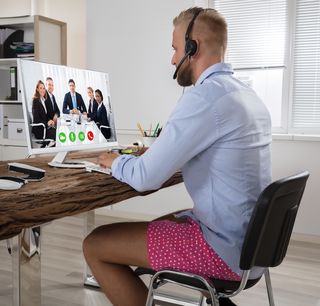Coronavirus Disease 2019
7+7 Strategies for Working from Home During COVID-19
How to successfully juggle work and kids without dropping any balls.
Posted March 16, 2020 Reviewed by Ekua Hagan

So, you find yourself suddenly having to work from home. Schools and daycares are closed. You not only have to continue being productive at work but also take care of and educate your children at the same time. COVID-19—thanks! What do you do?
Working from home has some advantages—no need to commute, having access to your own kitchen, being able to dress comfortably, and having more flexibility in your schedule. However, a sudden transition from the office to home may be challenging, especially if you also have children.
In this post, I offer some practical suggestions for navigating this transition from the perspective of work, family, and your wellbeing.
Work
The following are some tips on being efficient and productive while working from home.
1. Structure and boundaries: In compiling this list of suggestions, I checked in with Heather Hall, an entrepreneur in residence at JumpStart. Hall, who has worked from home for many years and taught others how to do it, says that the most important aspects of the transition to working from home are structure and boundaries. This is necessary to “help you focus on the day, and be able to step away at the end of the day.”
- Space: Make sure you have set up a dedicated workspace. If you have a spare room, that’s ideal. If not, you can set up at the kitchen island or dining room table, ideally next to the coffee machine. Arrange the equipment you need: laptop, chargers, phone, headphones, pen and paper, etc.
- Time: Get up at your regular time in the morning and follow your regular routine—take a shower, get dressed, and have breakfast. Do some exercise, yoga, or meditation if it is part of your routine. It may be tempting to work in your pajamas from your comfy couch or even your bed. However, you may find yourself feeling less motivated to work and more inclined to take a nap.
- Continuum: Instead of commuting to work, take a walk around the neighborhood to get your mind out of being-at-home mode and into work mode (while keeping social distance).
2. Social interaction is a very important part of the workplace. When the ability to interact is suddenly gone, your need for it is not. Fortunately, many video platforms are available—Zoom, Skype, WebEx, and Slack among others. “Take the Post-it note off your webcam and use the webcam,” says Heather Hall. She also suggests having a morning standup with your team via video: “What did you do in the past 24 hours, what are you doing in the next 24 hours, what are you stuck on, what do you need help with?”
3. Ask for help: In a typical workplace setting, when you are stuck on something, you can always check in with your coworkers to brainstorm about a solution. Working from home may create the feeling of having to solve every problem on your own. This increases the feelings of isolation and decreases efficiency. Use video or chat to ask your teammates for help when you need it. The ability to ask for help is crucial for your mental health as well as for your ability to do your job.
4. Flexibility: Take advantage of the flexibility that working from home offers—throw in a load of laundry in between meetings, or take a break to play with the kids as a reward for them letting you work uninterrupted (more on this later), or just take a mental health break.
5. Staying focused: Even in normal times it's not easy to stay focused on work for long periods of time. During the time of COVID-19, it is even more tempting to keep looking online or listening to the radio for the latest developments. Unfortunately, this is likely to reduce your productivity and increase anxiety. In order to stay informed without getting stuck, schedule a 15-minute news check for yourself twice a day—once in the morning and once in the evening. If you find yourself feeling anxious or distracted by searching out information about the virus, see my previous blog post on dealing with the anxiety of uncertainty.
6. Take breaks: Be sure to schedule those mental health breaks—time for lunch, and shorter 10- to 15-minute breaks throughout the day to take a walk, meditate, breathe, or just move your muscles. Muscle immobility is one of the most common reasons for muscle aches we so frequently experience while working at the computer. These are even more likely to happen if you are working at a make-shift space that lacks an ergonomic setup.
There are two kinds of movement breaks that will help: small movement and large movement. Small movement breaks do not require you to move away from your desk—just drop your hands from your keyboard to your lap, and move your upper body (roll your shoulders, gently roll your neck, twist at the waist to the right and left, stretch). Do this every 15 to 30 minutes. Large movement breaks require you to stand up and walk away from your desk. You might go for a brief walk, check-in with the kids, or do some full body stretches. Take large movement breaks every 1.5 to 2 hours. This will keep your muscles feeling better and provide you with a bit more energy and ability to focus.
7. Wind down: Once your workday is over, give yourself permission to step away and actually be done. Take stock of what went well throughout the day and what you might want to do differently tomorrow. Spend time with your family, and have time to wind down and get some sleep.
Family/kids
Kids being out of school is one of the biggest challenges of working from home, especially if both parents have to work or if you are a single parent. The following are some suggestions for how to balance taking care of the kids while being able to focus on your own work.
1. Structure and boundaries: Kids benefit from structure and boundaries in the same way as adults do. If your kids are older, sit down with them to set up a daily schedule. The schedule could include some school-related or other educational activities, reading, time outside, playtime, lunch/snack times, and times to check in with you. Be sure to leave time for a break after each educational activity.
2. Offer choices: For younger kids, Heather Hall of Jumpstart suggests setting out snacks and giving them a choice of three activities (more options than that is likely to be overwhelming), such as building with Legos, watching a show, coloring, or having quiet time in their room. If they are able to spend the predetermined amount of time involved in the activity, offer a reward, such as playing a game together during your work break.
3. Ask for help: If your oldest child can help supervise the younger one(s), discuss with them how this might work and offer a reward, such as one-on-one time with you, being able to choose a movie to watch, or extra time playing a video game.
4. Social interaction: If grandparents or other relatives have a more flexible schedule, ask them to video chat with the kids during the day—reading, or telling stories, solving logical puzzles together, or just chatting. It’s a double benefit—the grandparents, who may be socially isolated otherwise, get to spend time with their grandkids and the kids are entertained. Virtual playdates with friends could work in a similar way.
5. Communicate: If both parents are working from home, discuss an arrangement where the two of you switch off between working and spending time with the kids. A morning Standup that Heather Hall suggests for your work team would also be a good idea for your family—spend 15 minutes each night or each morning going over the plan for the (next) day.
6. Accept and manage interruptions: Having a plan will help reduce chaos but will not eliminate interruptions. Kids are kids, after all. You have some options for managing the interruptions:

- Heather Hall suggests using non-verbal communication cues to help kids recognize when you cannot be interrupted. For example, when Hall’s son was little and very much into Star Wars, she used to put a figure of Obi-Wan Kenobi in her doorway to let him know that he cannot come into her home office. Other nonverbal cues could include holding up a hand or a finger when you see the child coming to let them know that you are in a virtual meeting and it is not a good time.
- Hall also suggests using a sheet with tear-off tabs, like the ones we used to see on a bulletin board offering items for sale or looking for roommates. Only this one would have five tabs with numbered questions allowed for the day instead of phone numbers. The child would tear off a tab each time they have a question that they need to interrupt you with until they run out of questions.
- Schedule check-in time with the kids throughout the day, perhaps 15 minutes every two hours. This will give you a break from work, and the kids will know they have time with you coming up shortly to help them hold on to their questions and requests.
- Finally, accept that working from home will not be peaceful—dogs will bark and kids will walk into your workspace. Let your coworkers know this will happen and remember that the same thing will likely happen to many of them.
7. Outside help: In a pinch, if the kids are just too small to be able to spend time by themselves or if you need a longer uninterrupted stretch than your kids are able to provide, consider creating a babysitting coop with another family—only one, to limit contact and possibility of exposure to COVID-19. Perhaps you have a teenage neighbor that is able to help you a few hours a day, or an adult with a more flexible schedule.
Amy Husted, CMO of Wana family network and co-founder of an app called Komae, had instances just like these in mind. Komae, a babysitting coop app, is designed to connect families looking for occasional babysitting swaps. Pre COVID-19, these swaps were intended to give parents time for date nights and other self-care. The goal is different right now—they are working on helping people find necessary childcare while maintaining social distancing. Husted says: “We are encouraging people to maintain social distance, and figure out a way to swap care safely, perhaps buddying up with just one family to limit exposure … For healthcare workers, buddying up with someone who also works in healthcare, perhaps with a shift opposite to yours, to limit exposure.”




